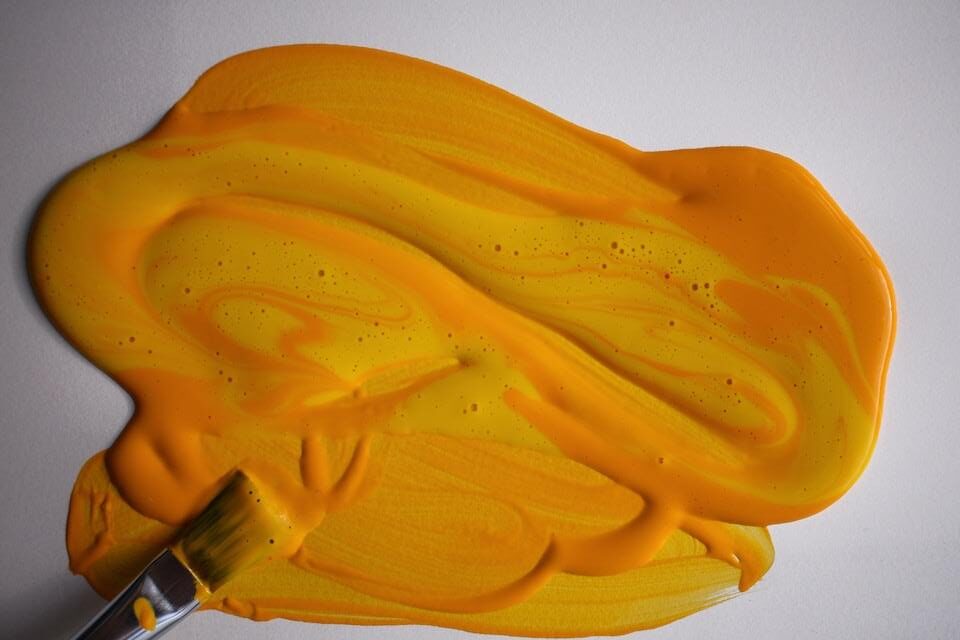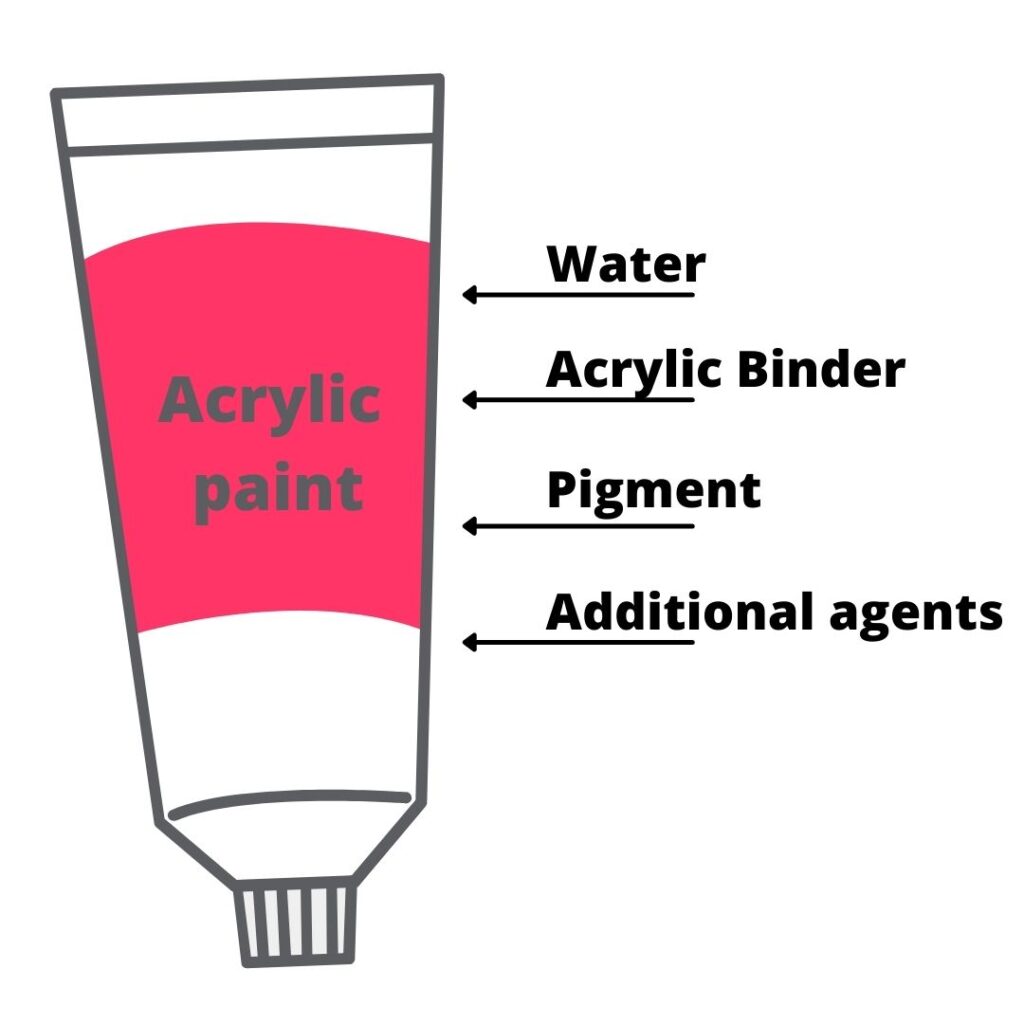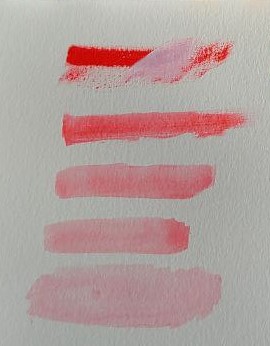Last Updated on December 20, 2023 by Masha Eretnova
Acrylic paint is a popular medium for artists, crafters, and DIY enthusiasts due to its versatility, durability, and ease of use.
However, many people wonder, “Is acrylic paint water-based or oil-based pr chemical-based” as there are conflicting info online.
The simple answer is yes, acrylic paint is a type of water-based paint. Acrylic paints are water-based, water-soluble and can be diluted with water.

But in this article, I will explore why some people say that acrylic can be chemical-based, what are the differences between water-based and solvent-based paints, the advantages of using water-based paints, and some downsides.
Whether you’re a beginner or an experienced artist, understanding the properties of acrylic paint and other types of paint can help you create beautiful, long-lasting works of art.
Table of Contents
This article contains affiliate links. It means no extra cost for you but a little commission (2-3%) for me to support my hobby and blog. Thank you!
Is Acrylic Paint Water-Based?
Acrylic paint is water-based, meaning that water is used as “solvent” in its composition. Water in acrylic paint is what allows us to actually paint with it.

Acrylic Paint Chemical Formula
- BINDER: Acrylic polymers (such as methyl methacrylate or butyl acrylate) that make up the binder. (20 to 60%)
- VEHICLE (solvent): Water, which is used as the primary solvent (up to 40%)
- Pigment suspended in binder (up 25%, in cheaper paints much less)
- Additives, such as surfactants, thickeners, and preservatives, that help to improve the performance of the paint. (5%)
Acrylic paint vs water-based paints
While almost all acrylic paint is water-based, not all water-based paints also have polymers and chemicals in their composition, which makes acrylic the most durable water-based paint on the market.
Other water-based paints we know are gouache, watercolor, tempera paints.
Most water-based paints are less durable and not permanent, while acrylics are water-resistant and pretty lighfast.
| Acrylic Paint | Water-based paints (gouache, watercolor, tempera) |
|---|---|
| Water-based + 100% polymers and additives | Water-based + gum Arabic or natural binders and additives like glue or chalk, very rare low amount of polymers |
| Water-resistant once dry, permanent | Not water-resistant and not permanent |
| Washable only while wet | Washable even once dry |
| Very lightfast (fade-resistant) | Not lightfast |
| Mold-resistant, rarely go bad | Can grow mold and go bad |
| Shelf life up to 15 years | Shelf life 5 years max |
| Archival quality of paintings | Non-archival quality of paintings |
| Great opacity | Great opacity, except watercolors – they are transparent |
| Can be expensive if professional | Can be expensive if professional |
| Best for: displaying your art, art for sale, paintings on wood, canvas,paper, glass, metal, etc; for outdoor furniture and walls, indoor high-traffic rooms and cabinets. | Best for: art and crafts, school projects, non-archival paintings. |
Is acrylic paint water soluble?
Yes, acrylic paint is water-soluble while wet. It can be thinned and diluted with water or washed off with soap and water.
This makes it easy to work with and clean up.
But at the same time, as acrylic paint has privilege to have some polymers in it, it dries quickly and forms a water-resistant, flexible, and durable finish.
That finish is no longer water-soluble.
Acrylic paint can be thinned with water to create a variety of effects, such as glazes or washes to imitate watercolor.
It can also be mixed with other water-soluble media, such as watercolor or gouache, to create unique painting effects.
Overall, the water-solubility of acrylic paint is one of its key advantages, making it a popular choice for artists, crafters, and DIY enthusiasts.
What happens if you add water to acrylic paint?

When you add water to acrylic paint it becomes more fluid and more transparent.
Most acrylic paint colors are very opaque by default and the colors look very intense and bright. Adding water you are reducing the opacity, the density of the coverage and the brightness of the colors.
If you add around 30% of water the colors will still stay vibrant, but the paint will flow better, cover bigger area.
If you add 50% of water to your acrylic paint, it will look like watercolor – a bit paler, transparent and washy.
However, as acrylic paint is not 100% water-based and also contains polymers, too much water can break the link between polymers and pigments.
The paint will loose its great qualities and may crack or fade faster over time.
Learn to proper thin acrylic paint with water and better with acrylic mediums.
Types of Water-Based Paints

Water-based paints are paints that use water as the primary solvent or carrier instead of traditional petroleum-based solvents, such as mineral spirits or turpentine to bond paint pigment.
Most known water-based paints are latex, acrylic paints, gouache, tempera paints, poster paint and watercolor.
An example of a solvent-based paint is oil paint.
Water-based paints are typically made up of pigments, binders, and additives that are suspended in water.
Water-based paints have several advantages over traditional solvent-based paints. They are low in volatile organic compounds (VOCs), which makes them better for the environment and for human health.
They also dry more quickly, are easier to clean up with soap and water, and have less odor than solvent-based paints.
Water-based paints are commonly used for interior and some exterior surfaces on walls, furniture, and crafts.
They come in a wide range of colors and finishes, including flat, eggshell, satin, semi-gloss, and gloss.
While gouache and watercolor are more matte, acrylics are satin to semi-gloss but you can always change the appearance with a medium or a varnish.
History of Water-Based Paints
The history of water-based paints dates back to ancient times, when natural pigments were mixed with water and used to decorate cave walls, body and other surfaces.
However, it wasn’t until the 20th century that water-based paints became widely available and popular.
In the early 1900s, chemists began experimenting with new types of synthetic polymers that could be used as binders in paints.
One of these polymers was acrylic resin, which was first developed in the 1920s by German chemist Otto Rohm.
Rohm’s discovery eventually led to the development of acrylic paints, which are water-based and have many of the same properties as oil-based paints but are…better in some ways.
In the 1940s, latex paints were introduced, which used synthetic rubber as a binder instead of acrylic resin.
Latex paints were initially used for industrial applications, but they soon became popular for residential use due to their ease of application, quick drying time, and low odor.
Modern latex paints no longer contain rubber but are still popular for home improvement.
Today, water-based paints are widely used for a variety of applications, including interior and exterior walls, furniture, crafts, and art.
They are available in a wide range of colors and finishes, and are known for their low VOC content, environmental friendliness, and ease of use.
Water-Based Paint Advantages
- Low VOC content and non-toxicity. Gouache, tempera and watercolor are more environmentally friendly.
- Easy cleanup: Water-based paints can be cleaned up with soap and water.
- Quick drying time (5 to 30 min).
- Lower odor than oil-based paints.
- Versatility: Water-based paints can be used on almost any surface, including walls, furniture, and crafts. They are available in a variety of colors and finishes, and can be used for both interior and exterior applications.
- Adheres extremely well to porous surfaces.
- Durability: Acrylic paints are known for their durability and resistance to fading, mold, cracking, and peeling.
- Mastering acrylic painting is easier than oil painting.
- Non-flammable.
Water-Based Paint Disadvantages
- Poorer adhesion to non-porous: Water-based paints may not adhere as well to certain surfaces, such as metal or glossy surfaces, without proper surface preparation.
- Most water-based paints are not permanent, except for acrylics.
- Most water-based paints are less durable: gouache, tempera or watercolor can fade, can’t be used on walls or exposed to moisture or extreme temperatures.
- Sensitivity to freezing: Water-based paints can freeze at low temperatures, which can cause them to become unusable.
FAQ
Is acrylic paint the same as water based paint?
Acrylic paint is a type of water-based paint, but not all water-based paints are acrylic. Acrylic paint is made up of pigment particles suspended in an acrylic polymer emulsion that that are transported by water.
This makes it easy to work with and clean up, and it dries quickly to a water-resistant, flexible, and durable finish.
Other types of water-based paints include latex paints, watercolor, gouache and tempera paints. These paints have different properties and are used for different applications.
Do acrylic paints mix with water?
Yes, acrylic paints mix with water. Acrylic paint is water-soluble.
The amount of water needed to thin the paint will depend on the desired consistency and the intensity of the color.
It’s important to note that adding too much water to acrylic paint can cause the paint to become too thin and lose its vibrancy.
It can also affect the adhesion of the paint to the surface. It’s best to add water to acrylic paint gradually and test the consistency on a separate surface before applying it to your project.
Is acrylic paint oil-based paint?
No, acrylic paint is not oil-based paint.
Oil-based paint is made up of pigment particles suspended in an oil-based solution, such as linseed oil or mineral spirits. It dries more slowly than acrylic and latex paint and has a strong odor.
While acrylics use 100% acrylic polymer as a binder instead of solvents or oils.
While both the acrylics and oil-based paints have their advantages and disadvantages, they are not the same and should not be used interchangeably.
Are most acrylic paints water based?
Yes, most acrylic paints are water-based. A
While some acrylic paints may contain small amounts of solvents or other chemicals, the vast majority of acrylic paints are primarily water-based.
Some acrylic paints can contain solvents if they are for automotive industry for example.
is acrylic latex paint water based?
Yes, acrylic latex paint is a type of water-based paint.
The term “latex” in acrylic latex paint refers to the use of synthetic polymers, such as styrene acrylic or vinyl acrylic, as binders in the paint.
Acrylic latex paint is known for its durability, flexibility, and resistance to fading, cracking, and peeling.
It is commonly used for interior and exterior walls, furniture, and rarely – crafts.
I hope it is clear now that it is not completely correct to call acrylic paints chemical or solvent based while up to 40% of their composition is usually water.
While being as easy to use as other water-based paints, acrylic definitely stands out with its unparalleled versatility and durability.
Acrylic paints are of my favorite! Along with gouache to be honest.
Choice between acrylic vs water based paint for your next painting project now must be easy-peasy! Happy painting!

Masha Eretnova, born in 1991, is a Buenos Aires-based certified teacher, artist, and member of the Professional Artist Association with 20+ years of personal painting journey.
She started painting and drawing very early and is now an international abstract artist and educator passionate about acrylic painting, gouache, and crafts.
Her works are part of international exhibitions and contests, including ArtlyMix (Brazil), Al-Tiba 9 (Spain), Exhibizone (Canada), Italy, and many more.
Besides her artistic pursuits, Masha holds a post-grad diploma in Teaching Film Photography and 2 music school diplomas: piano and opera singing.